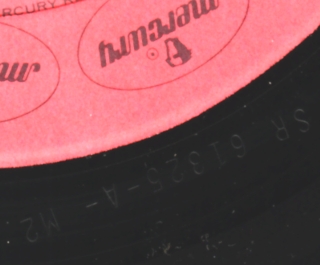"Identity" of design is a tricky term, though. Even the above example shows that there is always some minor variation - in this case concerning the label moulding (the groove pressed into the label) and the label code (LC) number, which is not present on the early 1970s record. All in all, all you can do is check the labels of a record very carefully to find out whether it's an original or not. Here's a - not necessarily complete - list of the label details that might be relevant to the question of whether a particular record is an original or not:
- the label colour
- the typeface of the text
- the exact spacing and position of the text
- additional information on the labels, like label codes ("LC...") on the labels of German LPs and records from neighbouring countries
- the copyright company listed on the labels (like "GEMA", "BIEM", etc. - often in a square box), and, if there is more than one such company listed, the order in which they are listed
- the details of the text running around the label margins
- the width of the space between that text and the label margins
- the label moulding (i.e. the way that grooves are pressed into the label) - which is why I also show white labels (of bootlegs, for example)
- and possibly other things I can't think of at the moment...



-label.jpg)
-label.jpg)
